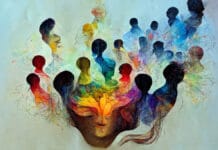Theatre of Alienation is a theatrical movement developed by Bertolt Brecht in the early to mid-20th century. It emerged as a reaction against traditional drama forms that sought to absorb audiences emotionally into a narrative. Instead of encouraging passive emotional engagement, Brecht aimed to create a theatre that provoked intellectual thought and critical reflection on social and political issues. His concept of Verfremdungseffekt, or the alienation effect, was designed to prevent the audience from becoming emotionally immersed in the story. Instead, it encouraged viewers to maintain a critical distance, allowing them to analyse and question the play’s themes and societal messages.
Brecht developed the Theatre of Alienation during profound social and political upheaval. Influenced by Marxist ideology, he believed that theatre should entertain and educate audiences about the mechanisms of oppression and class struggle. Unlike traditional theatre, which often reinforced dominant ideologies by making audiences sympathise with individual characters, Brecht’s plays aimed to expose the structures of power and the social conditions that shaped people’s lives. His works reflected his belief that human society was not static and that awareness and action made change possible.
Characteristics of the Theatre of Alienation
The Theatre of Alienation rejected the conventions of realism and naturalism, favouring a more didactic and self-aware form of drama. One of its defining characteristics was breaking the “fourth wall,” the invisible boundary between actors and audience. Instead of drawing spectators into an illusion, Brechtian theatre reminded them they were watching a play, a constructed representation of reality that could be analysed and debated. Actors frequently addressed the audience directly, provided commentaries on the action, or even stepped out of their characters to reflect on the scene.
Another key feature of Brechtian theatre was the use of episodic structures and non-linear narratives. Unlike conventional plays that followed a continuous plot with emotional development, Brecht’s works were often fragmented, composed of separate scenes or episodes presenting different perspectives. This structure reinforced the idea that the audience should not become emotionally absorbed but instead critically evaluate each scene in isolation.
Music and songs played a significant role in the Theatre of Alienation, but unlike traditional musicals where songs advanced the plot or deepened emotional engagement, Brecht used music to interrupt the narrative flow. Songs often contained ironic or contradictory lyrics that challenged the audience’s expectations. They were not designed to immerse viewers in the story but to reinforce the play’s themes and provide critical commentary on the action.
Visual elements in Brechtian theatre also worked against realism. Minimalist staging, stark lighting, and placards announcing scene changes were used to emphasise that the play was a constructed event. Costumes and props were often symbolic rather than historically accurate, reinforcing that the performance was an allegory rather than a reproduction of real life. Scenes were sometimes performed in an exaggerated, stylised manner to prevent emotional identification with the characters.
Acting in Brechtian theatre differed from the psychological realism associated with Stanislavski’s system. Instead of immersing themselves in their roles, actors performed detached and demonstrative, often shifting between narration and characterisation. They might comment on their actions or deliver lines in a deliberately unnatural way to disrupt audience identification. This style of acting prevented spectators from seeing characters as fully formed individuals and instead encouraged them to view them as representations of broader social and political forces.
Themes and Social Impact
Brecht’s Theatre of Alienation was fundamentally concerned with social critique and political change. His plays often dealt with themes of class struggle, capitalism, war, corruption, and injustice. Through his theatrical techniques, he sought to expose the mechanisms of power and highlight how individuals were shaped by social structures rather than being purely autonomous agents.
One of his most famous works, Mother Courage and Her Children, exemplifies the principles of alienation theatre. Set during the Thirty Years’ War, the play follows a woman who profits from war while suffering its consequences. Instead of inviting audiences to sympathise with Mother Courage emotionally, the play forces them to question the economic and moral systems perpetuating war. Similarly, in The Good Person of Szechwan, Brecht explores the contradictions of morality and financial survival, challenging viewers to reconsider their assumptions about goodness and justice in an unjust world.
The Theatre of Alienation sought to empower audiences rather than manipulate their emotions. Brecht wanted viewers to leave the theatre not feeling cathartic relief but with a sense of urgency and responsibility to engage with the social and political issues raised in the performance. He argued that theatre should function as a tool for education, helping people to understand their world and inspiring them to work towards change.
Influence and Legacy
Brecht’s Theatre of Alienation had a profound impact on modern theatre, influencing a wide range of playwrights, directors, and theatrical traditions. His ideas helped shape political theatre, documentary theatre, and avant-garde performance art. The principles of alienation can be seen in the works of Heiner Müller, Dario Fo, Augusto Boal, and Tony Kushner, among others.
Beyond theatre, Brecht’s techniques also influenced cinema and television. Directors such as Jean-Luc Godard, Rainer Werner Fassbinder, and Lars von Trier have employed Brechtian methods in their films, using self-reflexive storytelling, direct audience address, and fragmented narratives to encourage critical thinking rather than passive consumption.
The impact of Brecht’s ideas is also evident in contemporary theatre movements such as Applied Theatre and Theatre of the Oppressed. Augusto Boal, for example, developed Forum Theatre, which allows audiences to intervene in performances and suggest alternative courses of action, directly engaging with Brecht’s belief that theatre should lead to social change.
Theatre of Alienation revolutionised drama by shifting the focus from emotional immersion to intellectual engagement. Brecht’s techniques encouraged audiences to remain critically aware, questioning the structures of power and inequality rather than becoming absorbed in a narrative. Through his use of episodic storytelling, direct audience address, stylised acting, and anti-realistic staging, he developed a theatrical form that remains relevant in contemporary discussions about theatre’s role in society. His influence extends beyond the stage, shaping modern film, literature, and performance art, and continuing to inspire artists and activists who use theatre for education and social change.





























